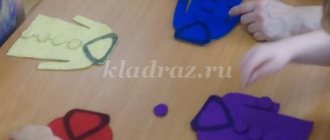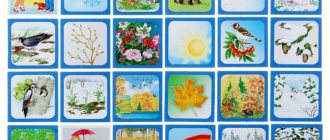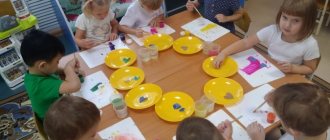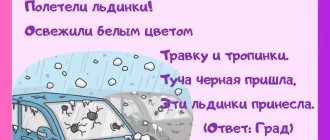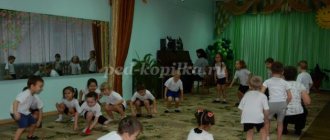Lesson summary “Introducing the Triangle”
Summary of the lesson on FEMP in the second junior group “Getting to know the triangle”
Form of organization:
joint activities of a teacher and a group of children.
Age group:
second youngest.
Materials and equipment: Visual material
: flat cardboard toys circle, square and triangle (with corresponding eyes, nose, mouth, arms and legs);
two flat houses), Katya doll, blue fabric (for the river), narrow and wide boards of the same color. Handout:
single-page cards with square houses pasted on them and contour images of triangle roofs (3 houses per card);
on the trays there are triangles (3 pieces for each child, corresponding in size to the contour images on the cards). Program content:
• introduce a new geometric figure - a triangle; • learn to distinguish and name a figure; • to develop children’s ability to distinguish it from other geometric shapes; • consolidate the skills of comparing two objects in width, learn to use words wider - narrower, equal in length; • cultivate an interest in mathematics, a desire to explore and learn something new.
Progress of the lesson
1.
Surprise moment.
Children with a teacher sit in a circle on the carpet.
Educator:
Guys, we have guests today.
Want to meet them? Children:
Yes!
If yes, then listen to the riddles, guess them and find out what kind of guests came to us.
I have no corners and I look like a saucer, like a medal, like a pancake, like an aspen leaf. I am an old friend to people. They call me... Circle
He has been my friend for a long time, Every angle in him is straight, All four sides are the same length. I'm glad to introduce him to you. And his name is... square.
The teacher shows cardboard toys circle and square.
Educator:
Guys, what are these figures called?
What are they like? Children:
Circle, square.
Educator:
That's right, it's a circle and a square. Let's take a closer look at them. What is the difference between a circle and a square? (bring the children's answers to the fact that a circle does not have corners, but a square does, that a circle has round legs, arms, eyes, nose and mouth, and a square has square ones).
Now listen to the story.
One day two figures went out for a walk. They are walking in a circle and a square, and someone comes towards them, guess who?
Three peaks are visible here, Three corners, three sides - Well, perhaps that’s enough! - What do you see? - … Triangle
Angry fish tail-shovel Bite off half a square - A whole corner, believe it or not! Who is he, poor thing, now? Triangle
Three peaks, Three corners, Three sides - Who am I? Triangle.
(show triangle).
The circle was amazed: “Oh, who is this strange one, not like us?” And the square asks: “Who are you?” “I am a triangle. I have 3 corners and 3 sides, that’s why I’m called that.” Let's all count the angles and sides of a triangle together and learn how to name it correctly. Allow children to examine the figures tactilely - in a motor way, children compare, find differences and similarities in all three figures (a square and a triangle have angles and sides, but they cannot roll, but a circle can, a square has more angles and sides, and a triangle less.
2. Game “Build houses” (on a magnetic board)
We met a circle and a square and a triangle and decided to play builders together.
How can you make a house, who wants to try? (Two children take turns and try to make 2 houses from a square and a triangle). Educator:
Well done, the houses turned out wonderful, the roofs are triangles, the walls are squares.
Look, something is missing in our houses. (Windows) Let's make windows from circles. (Children perform) Well done! Guys, let's sit down at the tables now. Each of you has houses on the pieces of paper, but they have no roofs. Let's make roofs. What shape do we need? Children:
Triangle.
(Children complete the task independently).
3. Physical school
Three cheerful brothers walked around the yard. Three cheerful brothers started a game. They made their heads - nick-nick-nick. With their dexterous fingers - chick-chick-chick. They clapped their hands - clap-clap-clap. They stamped their feet - stomp, stomp, stomp.
4. Game “Help Katya the doll cross the river”
Educator:
Guys, look who it is? This is Katya doll. But for some reason Katya is very sad. Let's ask her what happened. (Asks) Guys, Katya was walking through the forest and came to the river, but there is no bridge, so she cannot cross the river. Let's help her: let's build her a bridge. Look, I have two boards. Let's look at them. What are they? What colour? (Yellow) And in length? (Identical) And in width? (Wide and narrow) Next, the children build two paths and find out that Katya needs to walk along the wide path.
5. Summary of the lesson (reflection)
Guys, tell me, what geometric figure did we meet today? (With a triangle) How many figures were there in the fairy tale? (Three) What paths did we build? (Wide and narrow).
No. 1. Show your child the picture and tell him that Tanya is asking for help. You need to finish the drawing, i.e. circle all the triangles.
Will you help Tanya?
After completing the task, ask the child to show the largest triangle, the smallest.
If the child is not tired, invite him to color the picture. This can be done next time.
No. 2. Look at the picture with your child.
What do you think Tanya is doing? Listen to the child’s suggestions and tell her that Tanya is going to paint the window frames.
How many floors are there in the house? Help your child move his finger along the first (second) floor and name it.
What shape are the windows of the house? The child points to each window and names its shape.
How many round (triangular) windows are there on the first (second) floor? Show your child how to count circles (triangles) so as not to make mistakes: moving from left to right on each floor.
Tell your child that you need to start painting the frames (outline) from the top floor from left to right (show). First you need to paint the frames of all round, and then all triangular windows.
If the child shows interest in the task, then you can turn on the lights in the windows. If your baby is tired, do it next time.
No. 3. Show your child the picture.
What do you think Vanya is going to do? After the child’s answer, tell him that the neighbors asked Vanya to help build fences.
What is different about the houses around which Vanya makes fences? (One house is high, the other is low. One house has a round window, the other has a triangular window. One house is yellow, the other is green.)
The residents of the house with a round window asked to nail three more planks. The child draws and counts at the same time: one board, two, three.
Residents of a house with a triangular window want their fence to be longer. In this case, there is no need to count the boards.
No. 4. Tell your child that little Tanya really likes to do the task in her notebook.
Do you like doing this?
Invite your child to help Tanya complete the task.
Show and name all non-round objects.
Cross them out. Show your child how to cross out: with one line from the upper right corner to the lower left.
What items were left uncrossed? If your child lists these items, ask questions:
How are the uncrossed out objects similar? (They are all triangular.)
How many triangular objects are there in the picture?
Teach your child that the circles at the bottom of the picture should be colored from left to right (show), without skipping any.
Tanya thanks the child for his help.
No. 5. Tell your child that Tanya played mosaic.
What should you do after finishing the game? (You need to put away your toys.)
Invite your child to show Tanya how to do this.
What color mosaic does Tanya have?
What shape are the mosaic pieces?
Show all the small and all the big figures.
In order to put the figures in the boxes, you need to draw lines.
How many parts did you put in the red box?
How are these parts different?
How many parts did you put in the green box?
Tanya thanks the child.
Summary of GCD for FEMP in the middle group “Triangle”
Tatiana Chermoshentseva
Summary of GCD for FEMP in the middle group “Triangle”
Goal : Consolidate the names of geometric shapes.
Tasks:
Educational: introduce children to the triangle; exercise the ability to distinguish and name geometric shapes (circle, square, triangle).
Educational: make a house out of four triangles made from a square; develop sensory sensations.
Educational: cultivate kindness, the ability to sympathize, the desire to help; support in children the desire to complete what they start, following the motivation of the game.
Materials : For the teacher: a toy bunny, two squares (large and small, cut diagonally; “Wonderful bag” with a set of geometric shapes.
For children: two cards, each of which depicts one, two or three objects.
MOVE GCD
Guys, someone will come to visit us today! And to find out who, we need to solve the riddle!
Long ear
A ball of fluff.
Jumps deftly.
Loves carrots. (Bunny)
A bunny is brought into the group.
Let's say hello to him.
A bunny came running to us today. He is very cold and asks to make a house for him from the figures that you have (4 triangles). Let's help the bunny?
The called child tries to construct a house from 4 identical triangles, placing one on top of the other, but not overlapping one on top of the other.
Children should work independently, without prompting.
Then offer to compare the houses by size.
The hare thanks the children and says that he will live in one house and his brother in the other.
What shapes did we make houses from? From triangles! Let's look at it, count how many sides and angles it has?
And now the bunny will play with you!
D/i “Wonderful bag”
The bag contains geometric shapes familiar to children: circles, squares, triangles of different sizes.
The called child determines by touch the shape of the first figure he comes across, names it and takes it out of the bag.
Children determine the correct answer.
Then the child must name any object of the same shape. After the child has completed the task, the figure is put back into the bag. The teacher calls 5-6 children so that all the completed geometric shapes are named.
Gymnastics for the eyes “Draw a triangle with your eyes”
"Guess it"
Children have two cards with different numbers of objects.
The teacher claps three times. Children count, then pick up cards with the same number of objects and explain why they showed it. For example: “I have three balls and you clapped three times.”
“Let’s teach the bunny to lay out a triangle”
Guys, the bunny asks you to show what geometric shapes can be laid out from different materials.
Consider what is on the table (thread, beans, counting sticks).
What kind of geometric figure do you think can be made from string (beans, counting sticks? Children try to make different shapes.
Well done, what beautiful geometric shapes you have created.
The teacher gathers the children around him.
Who came to visit us? How could we help him? What figure did you meet?
Let's finally treat the bunny to tea? Children set the table in the doll's corner and treat the bunny with something.
